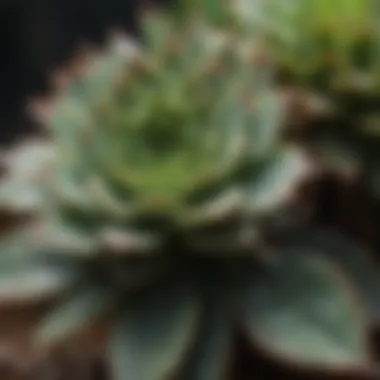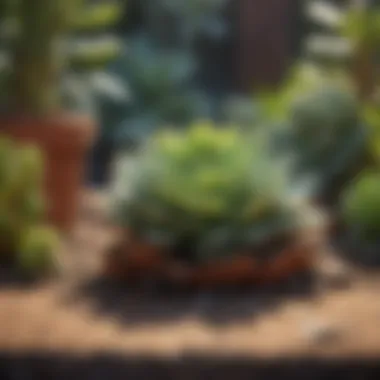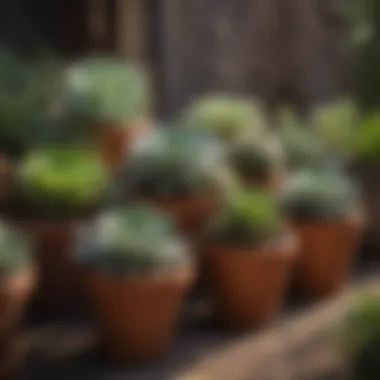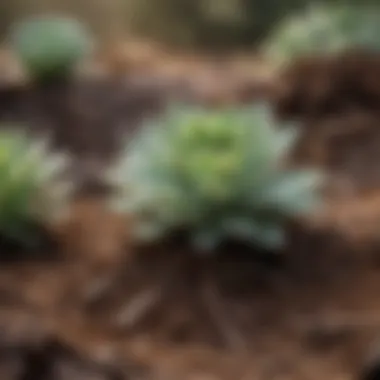Mastering Succulent Watering: A Complete Guide for Optimal Care


Gardening Know-How
Succulents, with their unique and captivating charm, have captured the hearts of many gardening aficionados. Properly caring for these plants is crucial to ensure their health and longevity. Among the various facets of succulent care, effective watering techniques play a vital role in maintaining thriving succulent gardens. Let's delve into the intricate world of succulent watering, exploring key strategies to keep your succulents flourishing.
Understanding Succulents' Watering Needs
Succulents, known for their fleshy leaves and water-retention abilities, have adapted to arid environments. Their unique structure allows them to store water for extended periods, making them resilient to drought conditions. Understanding this adaptation is essential in deciphering the watering requirements of succulents. Overwatering can be detrimental, causing rot and mold, while underwatering leads to dehydration and wilting. Achieving a delicate balance is key.
Identifying the Signs of Dehydration and Overhydration
To master proper watering techniques for succulents, it is crucial to recognize the signs of dehydration and overhydration. Dehydrated succulents often display shriveled leaves and a lack of turgidity, indicating the need for water. Conversely, overwatered succulents may show signs of yellowing, mushy leaves, and a foul smell emanating from the soil. By closely monitoring these indicators, you can adjust your watering practices accordingly to support the health of your succulents.
Establishing a Watering Routine
Creating a consistent watering routine is paramount in ensuring the well-being of your succulents. Factors such as pot size, soil composition, and environmental conditions influence the frequency of watering. Generally, it is advisable to water succulents when the top inch of the soil feels dry to the touch. Avoiding stagnant water in the pots and providing adequate drainage are additional measures to prevent overwatering.
Watering Techniques to Enhance Plant Health
Incorporating advanced watering techniques can further optimize the growth and resilience of your succulents. One method is bottom watering, where the plant absorbs water through the drainage holes, promoting root development. Alternatively, utilizing a spray bottle for targeted watering or employing a watering schedule based on the plant's specific needs can offer customized care. Experimenting with different approaches will help you identify the most effective technique for your succulent garden.
Conclusion
Mastering proper watering techniques for succulents is a rewarding journey that fosters a deeper connection with these remarkable plants. By understanding the nuances of succulent hydration, you can create an environment where your plants thrive and flourish. Whether you are a seasoned gardener or just embarking on your succulent journey, implementing these strategies will elevate your gardening experience and nurture a vibrant succulent oasis.
Introduction to Succulents
In this insightful article about succulents and their care, the focal point is watering, a critical aspect for these unique plants. Succulents, known for their water-storing abilities, require precise hydration to thrive. This guide's purpose is to delve deep into various watering techniques, providing readers with the necessary knowledge to foster healthy succulent gardens.


What Are Succulents?
Succulents are a diverse group of plants characterized by their thick, fleshy leaves and stems, adapted to store water in arid environments. These low-maintenance beauties come in a multitude of shapes, colors, and sizes, adding a touch of elegance to any living space. Their ability to survive with minimal water makes them appealing choices for both experienced gardeners and beginners.
Succulents: A Popular Choice for Indoor Decor
Succulents are favored for indoor decoration due to their aesthetic appeal and easy care requirements. Their striking appearance and ability to thrive in various light conditions make them ideal additions to homes, offices, or even event decorations. With a vast array of species to choose from, succulents offer endless possibilities for creative expression and personalized decor.
The Unique Watering Needs of Succulents
Understanding the specific watering needs of succulents is crucial for their overall health. Unlike typical houseplants, succulents prefer infrequent but deep watering sessions. Their water-storing adaptation means they are susceptible to root rot if overwatered. By considering factors such as potting mix composition, environmental conditions, and species variations, one can tailor a watering routine that suits the unique needs of these remarkable plants.
Factors Influencing Succulent Watering Requirements
In this elaborate article on Proper Watering Techniques for Succulents, the discussion around Factors Influencing Succulent Watering Requirements holds significant importance. Succulents, being unique plants, have specific needs when it comes to water intake. Understanding these factors is crucial in maintaining the health and longevity of succulents. By delving into the various elements that influence how succulents absorb and utilize water, readers will gain valuable insights into creating an optimal watering regimen
Understanding Succulent Species Variations
Drought-Tolerant Succulents
When contemplating Drought-Tolerant Succulents, their resilience in harsh conditions is a distinguishing feature. These succulents have evolved to store water efficiently, making them suited for arid environments. The key characteristic of Drought-Tolerant Succulents lies in their ability to thrive with minimal water, making them an ideal choice for locations with scarce moisture. However, this adaptation also means that overwatering can be detrimental to their health.
Moisture-Loving Succulents
Conversely, Moisture-Loving Succulents are a contrast to their drought-tolerant counterparts. These plants require more frequent watering and higher levels of humidity to flourish. The key feature of Moisture-Loving Succulents is their dependence on ample moisture for growth. While these succulents can add diversity to a collection, they necessitate careful attention to avoid drying out.
Environmental Considerations
Exposure to Sunlight


The exposure to sunlight plays a crucial role in succulent health. Succulents that thrive in bright, direct sunlight require adequate access to ensure photosynthesis and growth. Understanding the light requirements of succulents is vital in selecting suitable placement for optimal development. While sunlight is essential, too much exposure can lead to sunburn and dehydration of the plant.
Climate and Seasonal Changes
Climate and seasonal changes have a profound impact on succulent care. Adapting watering frequencies based on seasonal variations is essential to prevent over or under-watering. Succulents respond differently to temperature shifts and daylight duration, necessitating adjustments to maintain their hydration levels. By aligning watering practices with environmental changes, succulents can thrive throughout the year.
Potting Mix Composition
The Role of Drainage
The role of drainage in potting mixes is paramount for succulent health. Proper drainage ensures that excess water does not accumulate around the roots, preventing root rot and fungal infections. A well-draining soil blend allows for adequate aeration of the roots, promoting healthy growth. Lack of drainage can lead to waterlogging, ultimately damaging the succulent's root system.
Choosing the Right Soil Blend
Selecting the right soil blend is a critical consideration for succulent cultivation. A well-balanced mix that provides both drainage and moisture retention is optimal. The soil should be tailored to the specific needs of the succulent species, considering factors such as water retention, aeration, and nutrient content. By choosing a suitable soil blend, gardeners can create an environment where succulents can prosper and thrive.
Signs of Underwatering and Overwatering
In this article, the section on Signs of Underwatering and Overwatering plays a vital role in highlighting the crucial indicators that can significantly impact the health of your succulents. Succulents, known for their ability to store water in their leaves, are particularly sensitive to changes in hydration levels. Recognizing the Signs of Underwatering and Overwatering is essential for succulent caretakers to intervene promptly and adjust their watering practices accordingly. Succulents exhibit distinct responses to both underwatering and overwatering, making it crucial to understand and differentiate between the two to ensure the well-being of these unique plants.
Recognizing Symptoms of Underwatering
Identifying the symptoms of underwatering in succulents is imperative for maintaining their health and vitality. Succulents, by nature, are adapted to survive in arid conditions with minimal water availability. When a succulent experiences underwatering, it may exhibit visible signs such as wilting, drooping, or shriveling leaves. The leaves of the succulent may also become dry and brittle to the touch. Furthermore, growth may slow down or even stall as the plant redirects its resources to survive in the moisture-deficient environment. Recognizing these symptoms promptly enables caretakers to adjust their watering regimen and provide the necessary hydration to revive the succulent's health.
Identifying Indications of Overwatering
On the other hand, identifying the indications of overwatering is equally crucial to prevent detrimental effects on succulents. Overwatering can lead to root rot, a severe condition that can result in irreversible damage to the plant. Signs of overwatering include mushy or discolored leaves, a foul odor emanating from the soil, and a general decline in the plant's overall appearance. Succulents that are overwatered may also show signs of edema, where the leaves develop blisters or warty outgrowths due to excessive water uptake. By recognizing these indications, caretakers can adjust their watering frequency and ensure the optimal health of their succulents.
Best Practices for Succulent Watering


Proper watering techniques are paramount in succulent care, as these plants have specific needs that differ from typical houseplants. Succulents store water in their leaves, stems, or roots, making them drought-tolerant but susceptible to overwatering. Understanding when and how to water succulents is crucial for their health and longevity. By adhering to best practices, you can ensure your succulents thrive in their environment.
Establishing a Watering Schedule
Establishing a watering schedule is essential for succulents since they do not require frequent watering like traditional plants. Succulents prefer dry soil between waterings to prevent root rot. Factors such as the type of succulent, pot size, and environmental conditions play a role in determining the frequency of watering. By creating a consistent watering schedule based on these variables, you can maintain optimal moisture levels for your succulents' growth and development.
Watering Techniques for Different Succulent Types
Drench-and-Dry Method
The Drench-and-Dry method involves thoroughly soaking the soil and allowing it to dry out completely before the next watering. This technique mimics the natural watering cycle of succulents, which often experience periods of drought in their habitat. By providing a deep watering followed by a dry period, the roots are encouraged to grow deeply in search of water, promoting strong and healthy plant development. The Drench-and-Dry method is ideal for most succulent species, ensuring proper hydration without waterlogging the soil.\n
Bottom Watering Approach
Bottom watering entails placing the pot in a shallow container of water and allowing the roots to absorb moisture from the bottom up. This method prevents water from directly contacting the leaves, reducing the risk of fungal diseases and promoting efficient water uptake by the roots. Bottom watering is particularly useful for succulents with delicate leaves or those prone to rot, such as Haworthia and Echeveria. It provides a gentle yet effective way to hydrate your plants while maintaining soil integrity.
Utilizing Proper Watering Tools
Selecting the right watering tools is essential for successful succulent care. Tools such as a long-necked watering can or a squeeze bottle with a narrow spout help control the water flow and direction, preventing accidental leaf contact. Additionally, using a moisture meter can assist in determining the soil's moisture levels accurately, guiding your watering frequency. Investing in high-quality tools tailored to succulent care ensures precision and efficiency in watering, promoting healthy growth and vitality in your succulent garden.
Conclusion
In wrapping up this in-depth exploration of proper watering techniques for succulents, it is imperative to underscore the critical role of mastering the watering process. The conclusion serves as the culmination of a detailed discussion on succulent care, emphasizing the pivotal nature of providing adequate hydration to these unique plants for their optimal health and longevity. By delving into the nuances of watering techniques and schedules, this guide equips readers with essential knowledge to nurture flourishing succulent gardens effectively.
Mastering the Art of Succulent Watering
Delving into the intricacies of mastering the art of succulent watering unveils a multifaceted approach essential for plant enthusiasts. Understanding the specific watering needs of various succulent species, implementing appropriate watering procedures such as the drench-and-dry method or the bottom watering approach, and being diligent in monitoring soil moisture levels are key elements in achieving watering proficiency. Mastery in succulent watering requires a blend of precision, observation, and a deep appreciation for the unique hydration requirements of these plants.
Achieving Succulent Success Through Adequate Hydration
The path to achieving succulent success is paved with the fundamental cornerstone of adequate hydration. Maintaining a delicate balance in watering frequency and quantity is paramount to the health and vibrancy of succulents. By grasping the signs of both underwatering and overwatering, cultivators can fine-tune their watering habits to provide just the right amount of moisture for their plants' thriving growth. Adequate hydration acts as a catalyst for robust root development, vibrant foliage, and overall plant resilience.
Ensuring a Thriving Succulent Garden
The goal of ensuring a thriving succulent garden transcends mere plant care; it embodies a harmonious understanding between gardener and plant. By incorporating proper watering techniques, alongside considerations of light exposure, climate variations, and soil composition, individuals can create an optimal growth environment for their succulents. This holistic approach fosters not just physical health but also a deeper connection with the botanical realm. Nurturing a thriving succulent garden is a fulfilling journey of continual learning, adaptation, and appreciation for the resilience and beauty of these exquisite plants.







